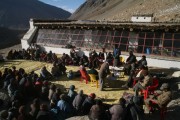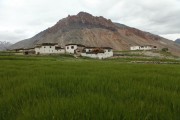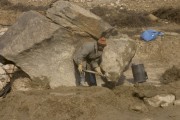Marek Tichy and Kateřina
A trip to the Himalayas had always been my childhood dream. The Sun School, however, was what gave meaning to the trip, and my wife Kata was the one who gave me the courage. At first, we wanted to spend two months in the school. Due to our limited vacation, unfortunately, the plan shrunk to only four weeks. The plane from New Delhi was touching summits in the rising sun when landing in Leh. It was a magnificent view over green valleys, the Indus River and the white caps on each of the peaks. In Leh, we enjoyed a variety of local food (garlic naans, momo-dumplings, soups and much more) while getting used to the lower oxygen level. During these three days, we were trying to get a local SIM card, purchase some missing medication and attend the Dalai Lama’s teaching. During his speech, the Dalai Lama was truly shining – yet quite differently from the time he had visited Prague – he was closer to his home, in the middle of his nation. Ladakh has had the largest diaspora of Tibetans for quite some time and thus whole families, thousands of people arrived. All in their best festive attire. After spending some beautiful time in Leh, we set out on our journey to Kargil, passing many military bases along the way. Perhaps the only place we did not come across any was at one of the highest-located car-accessible passes in the world. After that, we only had to cross Mulbekh (where you will find another Czech school) to reach Kargil. The locals hold a monopoly on taxi-transportation here. All the cars must drop their passengers here and they must continue with jeeps from Kargil. Comparing to Leh, Kargil makes you tired. You are clearly seen as a source of money, you are different. Therefore, we left for Padum as soon as possible. The journey is less than 200 km long, but it takes 14 hours in a crammed jeep to get there. Padum was the last place from where it was possible to send greetings to our families. On the other hand, people already knew Honza here, which was one of the reasons why we were helped: horses with horsemen were waiting for us in Anmu – the village where the road ends nowadays. Otherwise, we would have had to carry everything on our backs. After passing Phugtal, sleeping in Purney and having lunch with the family of the horseman, we reached Kargyak on the evening of the next day. 25 kilometers in a desert-landscape at 4,000 km above sea level was quite an exhausting experience indeed… What we had only seen in pictures turned out to be much more beautiful in reality. We were accommodated in the school, where classes were held immediately the following day. We found a way to connect and communicate with the children very fast and joined lessons with them already on the first day. Despite a slight lack of trust we felt from the teachers at first, we managed to get along well very quickly. At the time of our arrival, Honza and Jirka were away, the majority of the people from the village had left to Padum for the Dalai Lama’s teaching. This meant the whole plan of our visit had to be negotiated again on the spot. It was a little bit of a challenge even for a manager of a multinational corporation. Words like “time management” or “project delivery” gain new, surprising connotations around here. Originally, we had set ourselves 4 goals: to spend time with the children in activities we prepared for them, check the inventory of medicaments together with some elementary education on their usage. I was determined to perform a revision of the power generation unit and Kata planned to have a “women’s talk” with the local girls and women. There was no school on Sunday and so we headed to visit Kata’s local colleague representing the western type of medical care in Kargyak. He had served 2 months in a hospital as a receptionist and an orderly, due to which he was recognized with an outstanding position, salary and the government entrusted him with the distribution of western medication. There are 4 bags and some medical equipment in his house. You can choose from a variety of medicaments, from regular paracetamol, different types of contraception, up to multi-component medication for intravenous application. (The distribution of medicine is part of a governmental program to develop the most populated country in the world: each village must have a school, access to medical service and a TV satellite for every family – compared to an internet connection, a TV is a better one-directional and well controlled tool to influence.) After a couple of hours spent explaining the dosage checking the inventory, we decided to take an easier way: Kata created an easy-to-use manual covering the basic root-causes analyses and symptoms where western medicine can help and sometimes even save a life. Time runs differently in the village; time arrangements don’t quite mean what we are used to. Therefore, it was no surprise to learn that we were going to spend the next two days with the children on our own. There was an archery competition in a nearby village called Hi where the Kargyak team could not be missed. The plan was ready in a moment: activities with children, a trip to the archery competition, in the evening the Women’s talk while I take a close look at the power generation unit. We started the day with tower building (also known as the “Spaghetti-challenge”) right after the morning exercise. The goal is to build a tower using spaghetti and marshmallows. The higher, the better. However, the challenge is that the spaghetti is too thin to withstand weight of the marshmallows. After a short while, the children had to engage their brains and their everyday experience to figure out how to strengthen the tower structure. Some teams were rocking, some a bit less – e.g. due to the fact that they had eaten all the building material. Prior to our departure from Prague, we collected some older cameras from our friends to be able to teach the children how to take photos. Two cameras remained in the school, available for the children to record their special moments throughout the year. However, there was not much left of pictures we brought back – an antivirus program without updates doesn’t protect that very well… The ever-present dust doesn’t prolong the lifetime of installed electronics, and the sulfuric acid vapors from batteries don’t exactly help maintain cable insulation. Despite a significant effort put into cleaning different parts, re-assembling the DC-AC convertor and even partially restoring the system, this part of our mission didn’t come to a successful end. However, the director of the school learned what should be brought from Manali to make it work again. He even listened with interest to what needed to be done and interconnected to fix the system by themselves. We were a little bit surprised that they were not able to fix it themselves, given that they had similar convertors at home to supply power to their TV. It will still take some time for the school to be accepted as their own, with all the responsibility of running it. It will take time to really understand that the aim of Surya is not to create unhealthy dependency by pumping money and making the people of Kargyak 100% dependent. Surya should be perceived as a tool by means of which they will be able to cut the umbilical cord one day… Before noon, we set on our journey to Hi, where the teachers from Kargyak collected silver medals. Almost all youngsters (and especially the girls) celebrated the success together with the winners until early morning and only a couple of us went back to the village. Holding the intended women’s talk didn’t make sense at this point, and so we watched the movie Frozen. At first, we tried inspirational movies like The Man Who Planted Trees from Jean Cocteau, but Olaf and Disney’s princesses in a frozen kingdom charmed the kids. Let it go… On the very last evening, we were invited to the local council. We were given ceremonial scarves as an expression of appreciation. Having experienced such a moving moment and encouraged by a tasty dinner and the local beer, we climbed back to the school. Over the little fields with green barley waving in the wind. Over the bubbling streams of the irrigation system and under the clear sky with the moon pouring its silver light onto the whole valley. Just before we left, we got hot tea and some breakfast from the children. Other kids were waving when climbing to the school in their blue uniforms. An almost two-week journey up to Kargyak, tens of hours in jeeps, all that to spend a few days at the school. But – the reward was far better than anything we would have hoped for. The Czechs have a good name here thanks to this brilliant building and all the work invested. In this Himalayan village, where a lonely excavator is working on another part of the road under construction. “Once there will be a road here…,” we often heard with joy and high expectations in the voices of the locals, together with spectacular plans. It will take a couple more years though.

 In now days are hppening big changes in Jammu and Kashmir.
https://www.bbc.com/news/world/asia/india
In now days are hppening big changes in Jammu and Kashmir.
https://www.bbc.com/news/world/asia/india  On September 21st, Kargyak Sun School will celebrate the 10th anniversary of its opening. There, in one of the last places on Earth, the original Tibetan culture survives at the elevation of 4200 m. Before the school opened, the village of 200 heads had only 10 members who could read and write a little. To get an education, children were sent away to boarding schools in faraway towns. Today, the Sun School has its alumni and thanks to the project, people stopped moving away from the village.
On September 21st, Kargyak Sun School will celebrate the 10th anniversary of its opening. There, in one of the last places on Earth, the original Tibetan culture survives at the elevation of 4200 m. Before the school opened, the village of 200 heads had only 10 members who could read and write a little. To get an education, children were sent away to boarding schools in faraway towns. Today, the Sun School has its alumni and thanks to the project, people stopped moving away from the village.  PRAHA 22.11.2018 | 19:00 Betlémská kaple
BRNO 21.11.2018 | 19:00 Milosrdní bratři
PRAHA 22.11.2018 | 19:00 Betlémská kaple
BRNO 21.11.2018 | 19:00 Milosrdní bratři 


